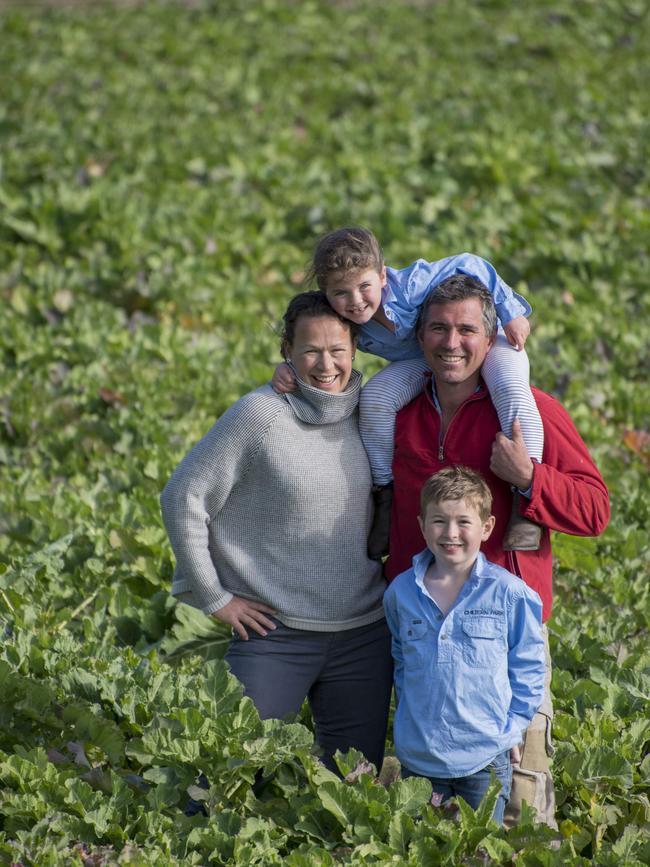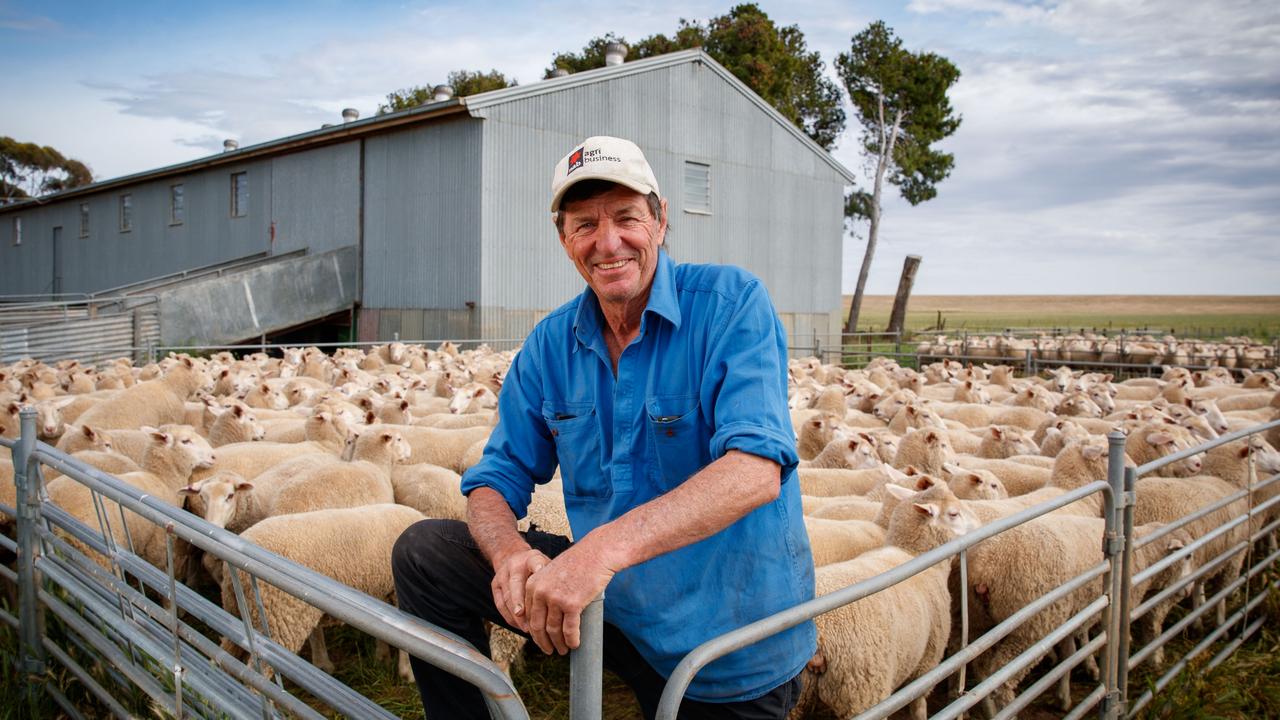Growing kale helps Ben Young feed his cattle in winter at Macarthur
IT’S hailed as a superfood for humans, but kale is a handy winter feed for cattle too, writes KATE DOWLER.
LIVESTOCK producer Ben Young has turned to a superfood to help him fill the winter feed gap in Victoria’s Western District.

Ben, who farms with wife Jane and father Peter at Macarthur, has found kale good fodder for mature cows, which in turn has allowed them to lock up pastures for calving cows and weaner cattle, and boost their growth rates.
MORE LIKE THIS: REIGN AND SHINE FOR MATTHEW AND RACHEL HINKLEY
The Youngs run 1100 Angus breeding cows, 1040 weaners and join 9500 Coopworth composite ewes on the family’s 1160ha farm, Chiltern Park, and 1050ha of leased country.
This represents significant growth in both land and stocking numbers since Ben returned to the farm in 2004. Then the Youngs ran 4500 Merino ewes producing 21-micron wool, plus weaner lambs, and 300 cows on 900ha.
BEN YOUNG
MACARTHUR
RUNS 1100 Angus breeding cows and 7400 Coopworth composite ewes
OPERATES across 1160ha of owned and 1050ha of leased country
HAS more than doubled stock numbers and land in past 13 years
USES kale to help fill the winter feed gap
While Ben and Peter run a sheep flock comprising 7400 August-September lambing Coopworth composite ewes and 3000 ewe lambs — 2100 of which are joined — their real passion is cattle.
Most cows calve in August-September with the remainder calving in March to May. Weaning takes place from January to March for the spring calves and September for the autumn-drop calves.
Eight years ago, in an effort to get a greater control over genetics — and price of these genetics — the Youngs moved into breeding Angus bulls. Chiltern Park Angus now sells 102 bulls a year commercially and retains 20 for the family’s own use.
“The stud is not based on bloodlines, sires are selected on genetic merit using EBVs (estimated breeding values) and genomic data and are also visually assessed,” Ben said.
Ben said the focus remained squarely on commercial production.
Commercial cattle are mostly sold as EU-accredited steers to South Australian feedlots for live export. Empty cows are sold over-the-hooks, to traders or through saleyards, both through direct sales and via an agent. Last year 400 pregnancy-tested-in-calf females were sold to local farmers.
GREEN DREAM
CHILTERN Park receives an average 750mm of rain a year and boasts pastures dominated by perennial ryegrass, sub clover, plus some phalaris, lucerne and phalaris and sub clover mixes.
In recent years Ben has identified two key areas to improve the operation’s productivity; filling winter feed gaps and raising young cows’ reproduction rates.
In regards to reproduction, his approach involves joining spring-calving heifers at 14-15 months, targeting an in-calf rate of 90 per cent with 95 per cent “achievable”.
The average in-rate calf for first calvers is 90 per cent but this varies greatly depending on the season. In adult cows, the Youngs aim for 95 per cent but admit 97 per cent is achievable. For autumn-calving cows, the target is 5 per cent lower for adult cows.
Heifers are joined in November, 12 days before adult cows, at a weight of 330kg-plus.
Ben has stopped using artificial insemination on commercial heifers because of costs and labour inputs. Instead, 14-15-month-old yearling bulls are mated at a rate of 15 per 300 heifers.
Heifers are pregnancy scanned and aged, calving in groups according to due dates.
Ben said getting first-calving cows back in calf was always a big challenge as they juggled the demands of rearing a calf while still growing themselves.
To overcome this, Ben avoids late-calving heifers and ensures they are at good joining weights in their first pregnancy.
He said it was most important to prioritise feeding because well-fed animals on nutritious feed were more fertile. Joinings are conducted in mobs of fewer than 100 cattle with no more than two or three bulls to reduce bull breakdowns.
WINTER WONDER
BEN said kale was also kicking goals when it came to overcoming slow winter growth rates and feed availability.
Last year, during the toughest weaner growth period, from July to early September, a lack of quality feed meant there was variation in growth rates in weaner management groups of zero to 0.9kg/day.
Ben said it was therefore important to prioritise stock classes: weaner steers were given top billing, followed by pregnant heifers, weaner heifers then adult cows. He also measured pasture feed on offer from April, and growth rates, and estimated future feed availability.
The Youngs have grown kale and fodder beets as extra sources of feed for the past few years. Ben said their biggest feed demand came from cows — who were also the most destructive and pugged up paddocks.
He sowed 17.5ha of regal kale in November 2016 to feed 400 cows for 48 days, supplemented with straw, during April and May. The following October 19ha of regal kale and 10ha of Caledonian kale was sown for cows and weaner calves, grazing at the end of May. A further 8ha of brigadier fodder beet was grown for weaner calves.
“Kale is a hardy, easy to grow, relatively low input-cost forage option,” he said. “It is basically my hay shed.”
GRAZE ANATOMY
THE cattle graze kale in strips, with an electric wire moved every two days.
Kale has an energy metabolism of 11-12 and protein of 13 per cent, while fodder beet provides 12-14ME and 10 per cent protein. In 2016, regal kale cost $448/ha to establish in one paddock but produced 8500kg of dry matter at a cost of $0.05/kg of DM.
A second paddock cost $601/ha, producing more dry matter, 11,000kg/ha, costing $0.05/kg of DM. This was during a season of very little rainfall from January to April. With such results, Ben said kale was a great solution for filling feed gaps, at a relatively low cost per kg of dry matter per hectare. “Cows appeared to gain condition and lighter cows had good access to feed, and were not as noticeable in the herd after 48 days,” he said.
Ben said kale also required low labour input and minimal equipment to establish. “I think it is better cow tucker than human tucker,” he said.
In contrast, fodder beet was expensive to establish, about $1600/ha, and cattle had to be carefully introduced to it. “However it’s a high energy based crop so should be very effective in improving growth rates in weaner cattle in winter,” he said.
While grass “remained king”, the fodder crops were useful in helping to ensure there was enough feed at the crucial times.
Ben said he was keen to try virtual fencing, when the State Government permitted its use. He said he also wanted to look at the potential benefits of twinning cattle and joining heifers at younger ages — “and whether forage brassica crops and other crops like maize or sorghum could fill summer and autumn feed gaps and enable us to produce quality grass fed cattle, year round.”
• If you know someone who deserves to be recognised as an outstanding farmer, let us know


